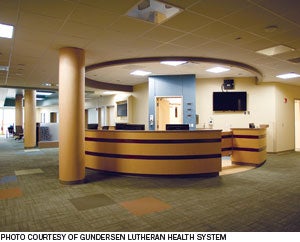Rise in behavioral health care facilities
 |
| Gundersen Lutheran's new behavioral health facility opens this month. |
As hospitals grapple with financial challenges caused by the Affordable Care Act and new federal reimbursement rules, some health care systems continue to build or plan to construct new behavioral health facilities.
According to the 2013 construction survey sponsored by Health Facilities Management and the American Society for Healthcare Engineering, 11 percent of respondents said behavioral health services projects are either currently under construction or are planned for the next three years at their respective health care systems or hospitals.
Of the types of facilities planned, 21 percent of survey respondents said new buildings; replacement, 17 percent; and expansion or renovation, 62 percent. An in-depth report on the survey begins on page 14.
As with hospitals in general, new behavioral health facilities emphasize patient safety and healing in an environment that resembles home, unlike many of the dreary mental health institutions of the past.
Gundersen Lutheran, La Crosse, Wis., was scheduled to start admitting patients this month to its new 34-bed inpatient behavioral health center.
The new facility offers private rooms for all patients, abundant windows for providing natural light, and soft colors and artwork for a more relaxing environment, says Kelly Barton, vice president, health system operations at Gundersen.
Ironically, the increase in new facilities comes as many states, communities and even other health care systems, cut mental health services. Of 71 counties in Wisconsin, only 17 offer inpatient psychiatric care and the number of beds has dropped from 13,000 to 2,000, Barton says.
"It's not a moneymaker, it's not a place where health care is going to make money," she says about behavioral health care services in general. "Gundersen Lutheran listened to the community, which said this is a need in our community."
A new $36 million, eight-story behavioral health facility that opened in December at Regions Hospital, St. Paul, Minn., offers more privacy for adult patients and their families. The new facility doubles the space of the prior outdated facility, originally built as a nursing student dormitory in 1964.
Two floors dedicated to behavioral health at the University of Minnesota Amplatz Children's Hospital, Minneapolis, are undergoing $16.5 million in renovations scheduled for completion in 2014. Plans call for renovation of two children's and adolescent behavioral health inpatient units and new or renovated physical therapy spaces.
The need to replace aging facilities that are unsafe or outdated is driving new construction and renovations, says Francis Murdock Pitts, FAIA, FACHA, OAA, president, architecture+, Troy, N.Y.
Also, state hospitals in particular are trying to consolidate psychiatric services into one building from multiple facilities or campuses to treat hundreds of patients instead of thousands as in years past, Pitts says.
"In order to get there, a lot of states are finding that they need to build a new hospital that is designed to serve as a more effective, diverse treatment setting," he says.
He says architecture+, which has been designing behavioral health care facilities for nearly 30 years, has some 10 projects across the United States in the design or construction phase and has experienced a major increase in behavioral health facility business since 2005.
Barton is hopeful that the trend in cuts for mental health services — frequently leaving hospitals with the job of picking up the slack — will reverse, especially in light of the shooting at Sandy Hook Elementary School, Newtown, Conn., which left 20 children and six adult staff dead.
"I do think that by providing good mental health services we can potentially reduce the cost of health care," Barton says. Gundersen Lutheran's new behavioral health facility opens this month.




